Related Research Articles
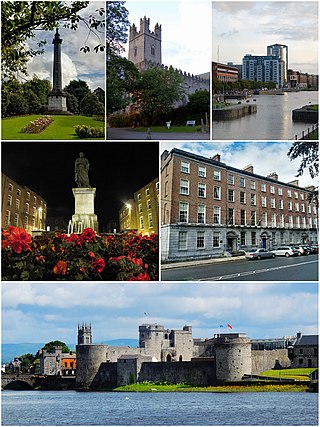
Limerick is a city in western Ireland, in County Limerick. It is in the province of Munster and is in the Mid-West which comprises part of the Southern Region. With a population of 102,287 at the 2022 census, Limerick is the third-most populous urban area in the Republic of Ireland, and the fourth-most populous city on the island of Ireland. It was founded by Scandinavian settlers in 812, during the Viking Age.

The Irish Georgian Society is an architectural heritage and preservation organisation which promotes and aims to encourage an interest in the conservation of distinguished examples of architecture and the allied arts of all periods across Ireland, and records and publishes relevant material. The aims of this membership organisation are pursued by documenting, education, fundraising, grant issuance, planning process participation, lobbying, and member activities; in its first decades, it also conducted considerable hands-on restoration activities.

The Hunt Museum is a museum in the city of Limerick, Ireland. The Hunt Museum holds a personal collection donated by the Hunt family, it was originally situated in the University of Limerick, before being moved to its present location in Limerick's Georgian custom house in 1997. The Custom House is situated on Rutland Street on the banks of the River Shannon at its confluence with the Abbey River. Among the museum's collection are works by notable artists and designers such as Pablo Picasso, Jack B. Yeats, and Sybil Connolly as well as distinctive historical items such as the O'Dea Mitre and Crozier.

Cork Opera House is a theatre and opera house in Cork in Ireland. The first venue opened in 1855 on Emmet Place to the rear of the Crawford Art Gallery. This original building was destroyed by fire in 1955, and a replacement opened in 1965. With a number of additions in the early 21st century, the 1000-seat venue hosted over 100 theatre, music, opera, and comedy events in 2015.
The architecture of Ireland is one of the most visible features in the Irish countryside – with remains from all eras since the Stone Age abounding. Ireland is famous for its ruined and intact Norman and Anglo-Irish castles, small whitewashed thatched cottages and Georgian urban buildings. What are unaccountably somewhat less famous are the still complete Palladian and Rococo country houses which can be favourably compared to anything similar in northern Europe, and the country's many Gothic and neo-Gothic cathedrals and buildings.
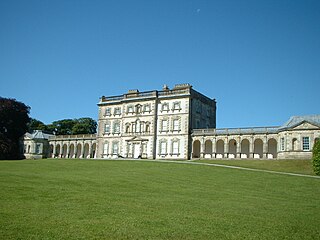
Florence Court is a large 18th-century house and estate located 8 miles south-west of Enniskillen, County Fermanagh, Northern Ireland. It is set in the foothills of Cuilcagh Mountain. The nearby village is distinguished by the one-word name Florencecourt. It is owned and managed by the National Trust and is the sister property of nearby Castle Coole. The other National Trust property in County Fermanagh is the Crom Estate.

The Swiss Cottage is an early 19th-century cottage orné located at Kilcommon near the town of Cahir, County Tipperary in Ireland. It is managed by the Office of Public Works and open to the public as a tourist attraction.
Brosna is a village and parish situated in the Sliabh Luachra area of County Kerry, Ireland. It lies 16 km (9.9 mi) from the town of Castleisland. The civil parish of Brosna consists of the village and a number of townlands. It is a mainly agricultural area, supporting two churches, two schools, a post office, and five public houses.
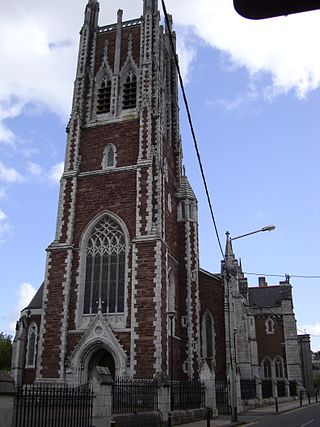
Sir John Benson ICE was an Irish architect, born in Collooney, County Sligo. Although most of his work was in Cork, he was knighted for his design for the Dublin Great Industrial Exhibition.

Newtown Pery is an area of central Limerick, Ireland, and forms the main city centre of the city. The district is known for its Georgian architectural heritage and is the core area of Limerick's Georgian Quarter. It is one of the three towns that make up modern-day Limerick City Centre, the other two being the older Englishtown and Irishtown, which date from the medieval period. Newtown Pery houses the largest collection of Georgian townhouses in Ireland outside of Dublin. In 1837, Samuel Lewis in his Topographical Dictionary of Ireland described Newtown Pery as "one of the handsomest towns in Ireland".
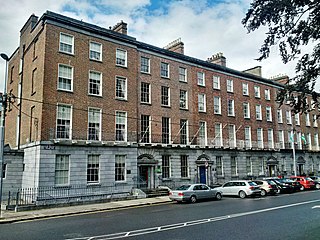
Pery Square is a Georgian Terrace located in the Newtown Pery area of Limerick city, Ireland. The terrace was constructed as a speculative development by the Pery Square Tontine Company between 1835 and 1838. The square was named in honour of the politician Edmund Sexton Pery. The terrace is notable as one of the finest examples of late Georgian architecture in Limerick and Ireland.
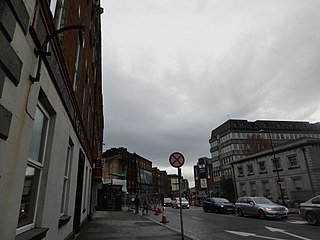
Rutland Street is a street in central Limerick, Ireland that forms part of the main central thoroughfare of the city which incorporates Rutland Street, Patrick Street and O'Connell Street. Named after the 4th Duke of Rutland, Charles Manners, who was appointed Lord Lieutenant of Ireland in 1784 and visited Limerick in 1785. Rutland Street along with nearby Bank Place features some of Limerick's earliest examples of Georgian Architecture. It was the first street developed as part of Edmund Sexton Pery's plans for Newtown Pery, and was the first part of the great Georgian expansion of Limerick south from the medieval city. In 1901, Irish nationalists suggested renaming the street to Hugh O'Neill Street.
Abraham Addison Hargrave (1755–1808), sometimes referred to as Abraham Hargrave the Elder was an architect and building contractor who was active mainly in County Cork, Ireland, in the late 18th and early 19th century. Born near Leeds, England, in 1755, Hargrave came to Cork between 1789 and 1791. Among his first commissions was the rebuilding of St Patricks Bridge in Cork, which had been damaged by severe flooding in 1789. Over the coming decades Hargrave was responsible for a number of merchant manor houses in the area. He was also involved in the development of several barracks and other works.
The 2022 National Football League, known for sponsorship reasons as the Allianz National Football League, is the 91st staging of the National Football League (NFL), an annual Gaelic football tournament for Gaelic Athletic Association county teams. Thirty-one county teams from the island of Ireland, plus London, compete; Kilkenny do not participate.

The Custom House is an early 19th-century building in Cork, Ireland. Originally developed as a custom house and opened in 1818, the Cork Harbour Commissioners took over the building in 1904. The Port of Cork Company vacated the building in early 2021. The Custom House is, together with a number of other buildings on the same site, listed by Cork City Council on its Record of Protected Structures.

The Custom House was a large brick and limestone building located at present day Wellington Quay in Dublin, Ireland which operated as a custom house, hosting officials overseeing the functions associated with the import and export of goods into and out of Dublin from 1707 until 1791. It also served as the headquarters of the Revenue Commissioners, as a meeting place and offices for the Wide Streets Commission and was said to be Dublin's first dedicated office building.
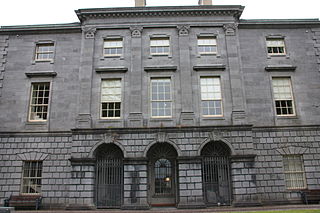
The Custom House is a Georgian-Palladian former custom house building in Limerick, Ireland. The building was constructed in local Irish limestone between 1765 and 1769 to a design by architect Davis Ducart.
References
- ↑ "Dictionary of Irish Architects - DUCART, DAVIS". dia.ie. Retrieved 1 June 2014.
- ↑ "Ducart, Davis - Dictionary of Irish Biography". www.dib.ie. Retrieved 4 October 2021.
- ↑ "Davis Ducart > Lifetime Lab". lifetimelab.ie. Archived from the original on 2 June 2014. Retrieved 1 June 2014.
- ↑ Richard Killeen, Ireland in Brick and Stone: The Island's History in Its Buildings (2012), p. 120
- ↑ "1769 - Hunt Museum (former Custom House), Limerick - Architecture of Limerick - Archiseek.com". archiseek.com. 11 November 2009. Retrieved 1 June 2014.
- ↑ "Hunt Museum | About Us | The Building". huntmuseum.com. Archived from the original on 2 June 2014. Retrieved 1 June 2014.
- ↑ "Irish Historic Houses Association - House Search". ihh.ie. Retrieved 1 June 2014.
- ↑ "Kilshannig". landedestates.nuigalway.ie. Retrieved 1 June 2014.
- ↑ "Kilshannig". Irish Georgian Society. Retrieved 4 October 2021.
- ↑ "Cork Hotels I Cork City Accommodation I Trabolgan Hotels". viennawoodshotel.com. Retrieved 1 June 2014.
- ↑ "1764 - Florence Court, Enniskillen, Co. Fermanagh - Architecture of Fermanagh - Archiseek.com". archiseek.com. 25 September 2009. Retrieved 1 June 2014.
- ↑ Christie, Christopher (2000). The British Country House in the Eighteenth Century. Manchester University Press. ISBN 9780719047251 . Retrieved 4 October 2021.